Lively 2025 Review
We found Lively’s medical alert device and mobile phones to be reliable, but the real value is in the subscriptions.
SafeHome.org may receive compensation from some providers listed on this page. Learn More
We may receive compensation from some providers listed on this page. Learn More
We found Lively’s medical alert device and mobile phones to be reliable, but the real value is in the subscriptions.
Some people struggle with iPhone and Android devices thanks to the number of complex settings and advanced features. This is where Lively comes in. The smartphone includes a simplified menu, large screen, and easy-to-read text. For the non-tech savvy folks, Lively offers a flip phone featuring a large keypad.
Lively also has a medical alert device, similar to those from Bay Alarm Medical and Medical Guardian. We tested the phones and medical alert device to see how they compare to the best medical alert systems on the market. Here’s what we found out.
FYI: A key difference between Lively and Bay Alarm Medical is that Lively doesn’t offer a smartwatch. If you’re looking for this type of device, check out our guide on the best medical alert watches.
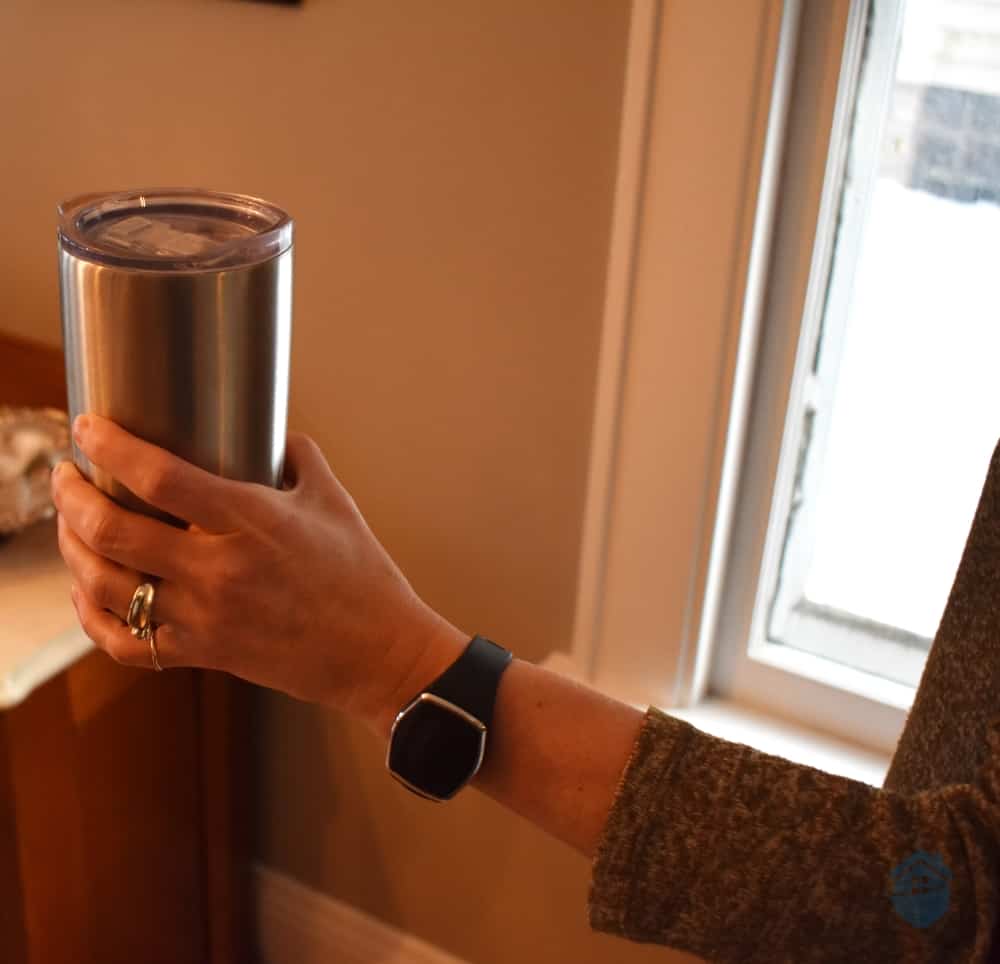
We wore our Lively Mobile2 on our wrist, but we missed the features from medical alert system smartwatches.
Check out more recommendations from the SafeHome team:
Lively has three products available – two phones, and a one-touch medical alert device. Let’s take a closer look at each one.
The Mobile2 resembles traditional medical alert pendants. You can hang it around your neck, attach it to your belt, or wear it on your wrist. It also includes essential features like GPS and optional fall detection.
Expert Tip: Over 14 million older adults fall annually, making it the leading cause of fatal and nonfatal injuries in this demographic.1 While medical alert systems with fall detection can’t prevent these accidents, they can get help fast.
One of the Mobile2’s drawbacks is the battery life. When we tested Medical Guardian’s MGMini, the device lasted five days before needing a charge. The Mobile2 needed charging after two days.
We like that the Mobile2 survived our water tests. It survives immersion in water at 3.3 feet for up to 30 minutes, making it suitable for baths, but not pools. The device also uses cellular networks to communicate with monitoring centers, so you don’t have to rely on your home internet connection.
>> Find Out: Best Waterproof Medical Alert Systems
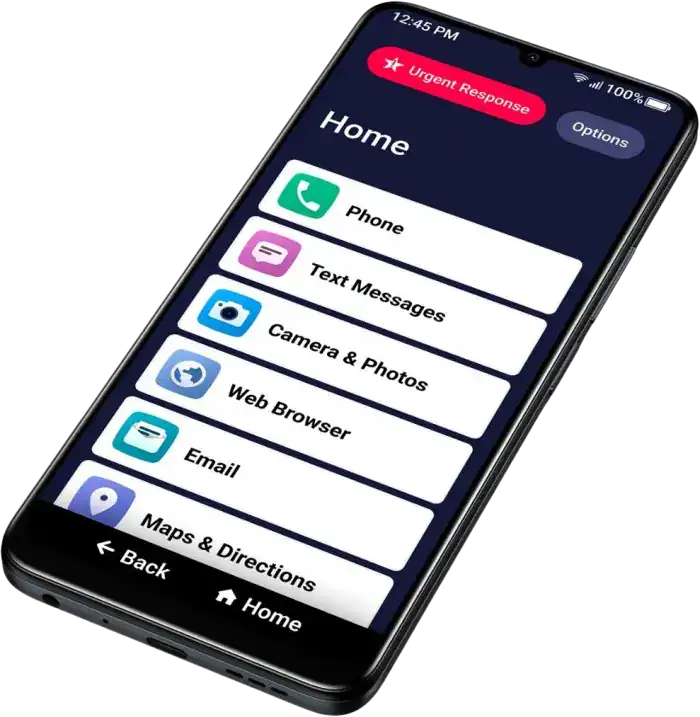
The Jitterbug Smart2’s 6.75 inch touch screen makes it easy to navigate menus, make calls, and send messages.
If iPhones and Samsung smartphones feel too advanced, check out the Jitterbug Smart4. You won’t need to change the font size. The default should be large enough for most seniors. We also like that the urgent response button is accessible in the menu, just in case you need fast access to it in an emergency.
The Smart4 is even hearing aid-compatible and lets you dial and text via voice. We also tried out some of the preloaded brain games. They tested our memory and reflex times. It’s a nice addition considering research shows that video games offer several benefits for older adults, including decreasing the risk of dementia.2
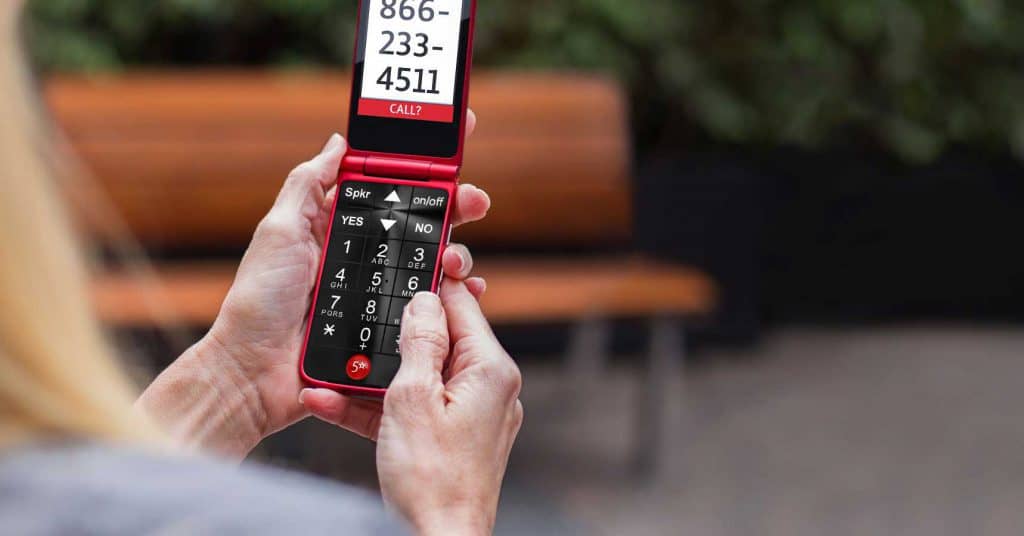
The Jitterbug Flip2 is better suited for the non-tech-savvy older adults in your life.
The Jitterbug Flip2 is ideal for older adults who don’t need internet access. It features a 3.2 inch screen that you use to navigate contacts, read text messages, and take photos. We like the keypad, which has big buttons, including a red one for the urgent response center.
For active older adults, we recommend the Flip2 over the Smart4. We found it easier to carry in our pocket due to the compact design. Like the Smart4, it’s hearing aid-compatible and has a 3.5 mm headset jack. You can’t increase the storage capacity, but it comes with 16 GB of space. That should be plenty of room for photos.
Here’s a summary of how much it costs to sign up for Lively subscriptions and get their devices.
The Lively Mobile2 costs $79.99, which is cheaper than Bay Alarm Medical’s SOS All-in-One 2 ($149). You can add accessories including:
The Jitterbug Smart4 is $119.99 and the Jitterbug Flip2 is $79.99. Lively offers multiple accessories including glass screen protectors, extra wall chargers, and headphones at affordable prices.
>> Read More: The Most Affordable Medical Alert Systems
It gets more confusing when choosing a Lively subscription. The prices are different for every device even though they include similar features like Lively Rides, Urgent Response, and on-call nurses. Here’s an overview of the prices.
| Basic | Preferred | Premium | |
|---|---|---|---|
| Mobile2 | $24.99 per month | N/A | $34.99 per month |
| Flip2 | $14.99 per month | $34.99 per month | $44.99 per month |
| Smart4 | $19.99 per month | $39.99 per month | $49.99 per month |
FYI: These prices include the paperless billing discounts. If you still like getting your bills in the mail, you’ll need to pay an extra $5 a month.
There are extra costs that apply when you buy your device. Some are optional and can be added or removed from your plan any time.
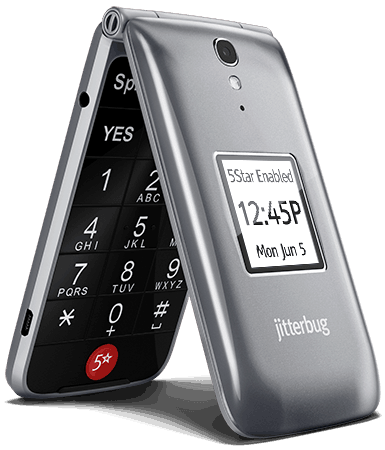
We paid the activation fee for the Flip2, but we didn’t need to pay extra for the talk minutes and texts.
Our first test of the Lively Mobile2 went smoothly. Wearing the device on our wrist, we pressed the single black button and an urgent response agent quickly answered. The response time for this first call was 17 seconds, which is fast. You can see it for yourself in the video we made below.
The Jitterbug Smart4 and Flip2 delivered similar response times to the Mobile2. The Flip2 has a red button at the bottom of the keypad to access the urgent response team. The Smart4 displays the option at the top of the menu, and the screen mimics an iPhone call when connecting.
The Smart4 and Flip2 work great as phones. We made calls, sent messages, and played a few brain games to keep us sharp. Both phones lack vital medical alert system features, though. For example, there’s no fall detection. On the bright side, both phones include GPS, so the urgent response team can pinpoint your location if you’re injured.
Expert Tip: We recommend testing your GPS before vacationing, especially if you’re among the 63-percent of travelers over 50 planning a domestic trip.3 All of Lively’s products can access the urgent response center in the U.S., but international coverage isn’t available.
Lively sits on our list of best medical alert systems with GPS and fall detection. The only catch with fall detection is that it works exclusively with the lanyard. We prefer wearing ours on our wrist, but made the adjustment to test it out.
The Mobile2 detected the fall every time. An alert message played when detecting the fall before connecting us to the urgent response team. It was just as fast as pressing the button, so within 20 seconds.
>> Learn More: Best Medical Alert Systems Worn as Necklaces
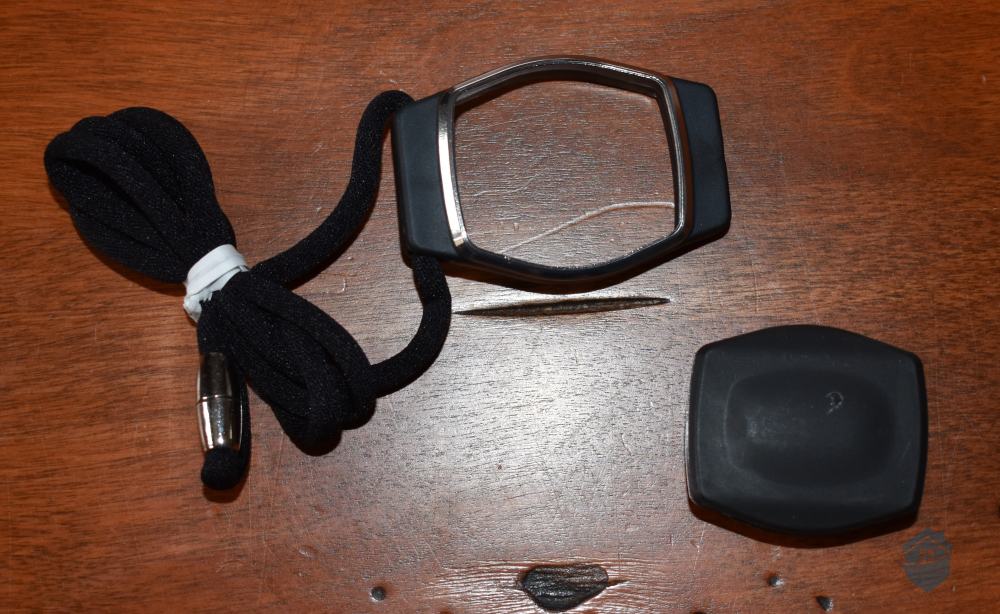
The Mobile2 fall detection feature only works when attached to the lanyard
We used the Lively app to access features from our plan. There are buttons to connect to an agent to ask general health questions. You can also access the on-call nurses to get medical advice and prescriptions filled.
The Urgent Response button is also located in the app for easy access. The design is user-friendly and simple to navigate. We checked in regularly to get daily health tips and check our step count.
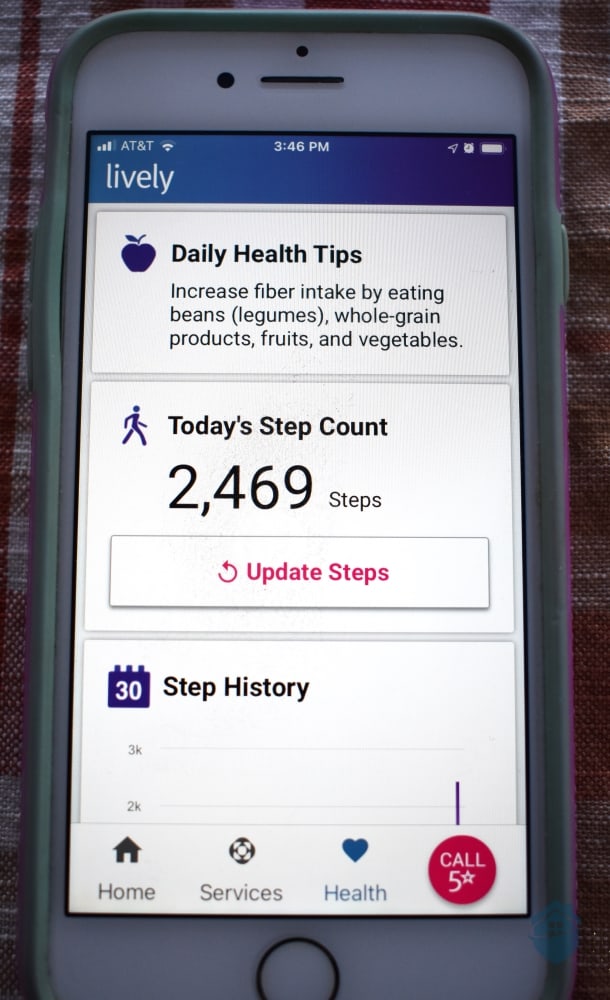
Checking in on how many steps we’ve taken today while getting our daily health tip.
If you’re already attached to your phone but like the look of Lively’s service, you can sign up for a BYO phone plan. You can find Starter Kits at Best Buy . Once you’ve signed up, you can download the app and access all subscription features.
Lively offers caregivers and family members a separate free remote monitoring app. We noticed a lot of the same features as the Lifeline app we reviewed. Some of them include:
Lively devices differ significantly from other medical alert systems. Here’s how they stack up against two of our favorites.
We mentioned earlier that the Lively Mobile2 and SOS All-in-One 2 share some similarities. The most obvious difference is that Bay Alarm Medical offers an at-home device as well as products you can wear on your wrist. The SOS Micro and SOS Smartwatch even have fall detection.
Bay Alarm Medical’s prices are similar to Lively. Fall detection with Bay Alarm Medical is an extra $10 and subscriptions start at $24 per month. Lively charges a $35 activation fee, but Bay Alarm Medical has device fees for some equipment that range from $89 to $159.
>> Read More: Bay Alarm Medical 2025 Review
Medical Guardian and Bay Alarm Medical have similar products. The MGMove and MGMini Lite we reviewed can be worn on wrists and have optional fall detection.
Lively wins on affordability. Medical Guardian’s prices are more expensive for equipment and subscriptions. The only package that’s cheaper is the MGClassic. Subscriptions start at $33 per month subscription and you don’t pay the equipment fee.
>> Check Out: Medical Guardian 2025 Review
We find the best way to assess medical alert systems is by testing them ourselves. Our team spends weeks or even months at a time with devices, evaluating criteria like usability, reliability, and included features.
Our team studied multiple features when assessing medical alert systems. Some of the criteria we looked at include:
Our team of senior care experts conducted all tests on the medical alert pendant and phones. They have over 50 years of combined experience in the industry and know exactly what to look for when testing medical alert systems. We also spoke to experts in the field and real customers to gather insights on how they use their products.
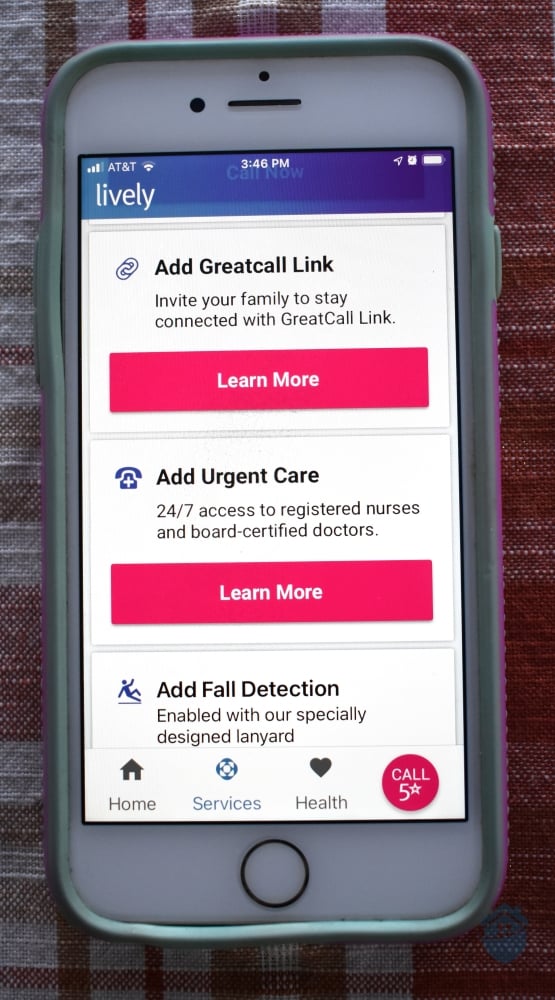
We tried all of Lively’s extra features to see if they were worth the extra costs.
Lively offers some excellent perks with its medical alert device and phones. Monitoring agents can answer general questions, arrange Lyft rides, and refill prescriptions. Lively’s apps also benefit users and caregivers, letting them check in remotely any time.
As for the equipment, Lively offers a quality medical alert pendant, but fall detection is limited to the lanyard. Lively’s phones are user-friendly alternatives to Apple and Samsung smartphones, although they’re missing vital medical alert features. They might not suit all older adults.
The Jitterbug phones range from $79.99 to $119.99. You’ll also have to pay a $35 activation fee and the first month of your Lively subscription which starts at $14.99 per month.
There are no setup fees but Lively charges a $35 activation fee. You can easily avoid that fee, though, by calling Lively to activate your device instead of activating it in-store.
If you run out of data, you’ll be charged $0.02 per MB for the remainder of the billing cycle.
You can use your current phone with any Lively plan including their plans with Urgent Response. That lets you turn almost any cellular device you own into a medical alert device.
Yes, you can switch or cancel plans anytime. You’ll need to call the customer service team to discuss your options.
CDC. (2024). Older Adult Falls Data.
https://www.cdc.gov/falls/data-research/index.html
BMC. (2024). Associations of computer gaming with incident dementia, cognitive functions, and brain structure: a prospective cohort study and Mendelian randomization analysis
https://alzres.biomedcentral.com/articles/10.1186/s13195-024-01496-7
AARP. (2024). 2024 Travel Trends: Despite High Costs and Travel Challenges, Older Travelers' Plans Hold Steady.
https://www.aarp.org/pri/topics/social-leisure/travel/2024-travel-trends/